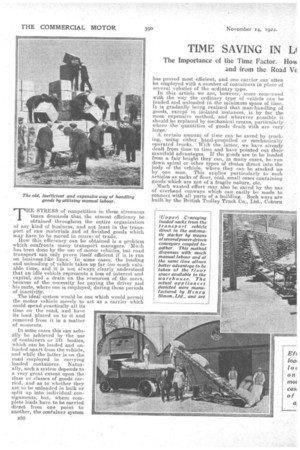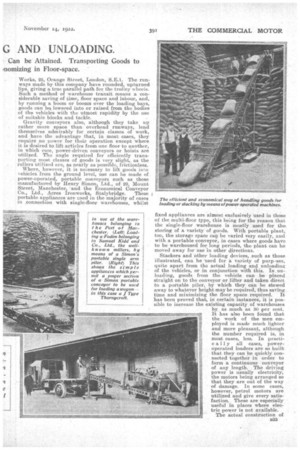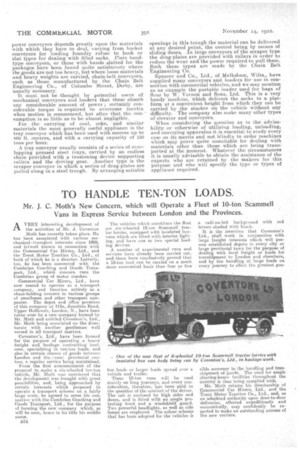TIME SAVING IN Li G AND UNLOADING.
Page 16

Page 17

Page 18

If you've noticed an error in this article please click here to report it so we can fix it.
HE STRESS of competition in these strenuous times demands that the utmost efficiency be obtained throughout the entire organization of any kind of business, and not least in the transport of raw materials and of finished goods which may have to be moved in course of trade.
How this efficiency can be obtained is a problem which confronts many transport managers. Knelt has been done by the use of motor vehicles, but road transport can only prove itself efficient if it is run on business-like lines. In some cases, the loading and unloading of vehicle takes up far too much valuable time, and it is not always clearly understood that an idle vehicle represents a loss of interest and capital, and a drain on the resources of the users, because of the necessity for paying the driver and his mate, where one is employed, during these periods of inactivity.
The ideal system would be one which would permit the motor vehicle merely to act as a, carrier which could spend practically all its time on the road, and have its load placed on to it and removed from it in a matter of moments.
In some cases this can actu. ally be achieved by the use of containers or lift bodies, which can be loaded and unloaded apart from the vehicle, and while the latter is on the road employed in carrying loaded containers. Naturally, such a system depends to a very great extent upon the class or classes of goods carried, and as to whether they are to be unloaded-in bulk or split up into individual consignments, but, where complete loads have to be carried direct from one point to another, the container system.
has proved most efficient, and one carrier can often be employed with a number of containers in place of several vehicles of the ordinary type. In this article we are, however, more concerned with the way the ordinary type of vehicle can be loaded and unloaded in the minimum space, of time. It is gradually being realized that man-handling of goods, except in isolated instances, is by far the most expensive method, and wherever possible. it should be replaced by mechanical means, particularly where the quantities of goods dealt with are very large.
A certain amount of time can be saved by trucking, using either hand-propelled or mechanically operated trucks. With the latter, we have already dealt from time to time and have pointed o-ut their manifold advantages. If the goods are to be loaded from a fair height they can, in many cases, be run down spiral or other types of chutes direct into the body of the vehicle, where they can be stacked up by one man. This applies particularly to such articles as sacks of flour, coal, small cases containing goods which are not of a fragile nature, etc.
Much wasted effort may also be saved by the Imo of overhead runways which can' easily be made to connect with all parts of a building. Such ways are built by the British Trolley Track Co.,, Ltd., Coburn Works, 25, Orange Street, London, S.E.l. The runways made by this company have rounded, upturned lips, giving a true parallel path for the trolley wheels. Such a method of warehouse transit means a considerable saving of time, floor space and labour, and, by running a boom or booms over the loading bays, goods can be lowered into or raised from the bodies of the vehicles with the utmost rapidity by the use of suitable blocks and tackle.
Gravity conveyors also, although they take up rather more space than overhead runways, lend themselves admirably for certain classes of work, and have the advantage that, in most cases, they require no power for their operation except where it is desired to lift articles from one floor to another, in which ease, power-driven conveyors or hoists are utilized. The angle required for efficiently transporting most classes of goods is very slight, as the rollers utilized are, as neaiNly as possible, frictionless. Where, however, it is necessary to lift goods into vehicles from the ground level, use can be made of power-operated, portable conveyors such as those manufactured by Henry Simon, Ltd., of 20, Mount Street, Manchester, and the Economical Conveyor Co., Ltd., Acres Ironworks., Stalybridge. These portable appliances are used in the majority of eases in connection with single-floor warehouses, whilst
fixed appliances are almost exclusively used in those of the multi-floor type, this being for the reason that the single-floor warehouse is mostly used for the storing of a variety of goods. With portable plant, too, the storage space cap be varied very easily, and with a portable conveyor, in eases where goods have to be warehoused for long periods, the plant can be moved away for use in other directions.
Stackers and other loading devices, such as those illustrated, can be Used for a variety of purp.,ses, quite apart from the actual loading and unloading of the vehicles, or in conjunction with this. In unloading, goods from the vehicle can be placed straight on to the conveyor or lifter and taken direct to a portable piler, by which they can be stowed away to whatever height may be required, thus saving time and minimizing the floor space required. It has been proved that, in certain instances, it is possible to increase the existing capacity of warehouses by as much as 30 per cent. It has also been found that the work of the men employed is made much lighter and more pleasant, although the number required is, in most eases, less. In practis cally all cases, poweroperated loaders are so built that they can be quickly connected together in order to form a continueus conveyor of any length. The driving power is usually electricity, the motors being arranged 8o that they are out of the way of damage. In some cases, however, petrol motors are utilized and give every satisfaction. These are especially useful in places where electric slower is not available.
The actual construction of power conveyors depends greatly upon the materials with which they have to deal, varying from bucket conveyors for loading foundry refuse to hook or slat types for dealing with filled sacks. Plain bandtype conveyors, or those with bands slatted for the packages have been found quite satisfactory where the goods are not too heavy, but where loose materials and heavy weight's are carried, chain-belt 'conveyors, such as those manufactured by the Chain Belt Engineering Co., of Colombo Street, Derby, are usually necessary.
'It must not be thought by potential users of mechanical conveyors and loaders that these absorb any considerable amount of power ; certainly considerable torque is required to overcome inertia when motion is commenced, but after that theconsumption is so little as to be almost negligible.
For the carrying of coal, coke, and similar materials the most generally useful appliance is the tray conveyor which has been used with success up to SOO ft. centres, and with a carrying capacity of 160 tons per hour.
A tray conveyor usually consists of a series of overlapping pressed steel trays, carried by an endless chain provided with a tensioning device supporting rollers and the driving gear. Another type is the scraper conveyor in which a series of drag-plates are pulled along in a steel trough. By arranging suitable openings in this trough the material can be delivered at any desired point, the control being by means of sliding doors. In large conveyors of the scraper type the drag-plates are provided with rollers in order to reduce the wear and the power required to pull them. Both these types are made by the Chain Belt Engineering Co.
Spencer and Co., Ltd., of Melksham, Wilts., have supplied many conveyors and loaders for use in connection with commercial vehicles, and we may mention as an example the portable loader used for bags of Hour by W. Vernon and Sons, Ltd. This is a very handy machine, which delivers the sacks to a platform at a convenient height from which they can be carried by the stacker on the vehicle without any difficulty. The company also snake many other types of elevator and conveyors.
When considering the question as to the advisability. or otherwise of utilizing loading, unloading, and conveying apparatus it is essential to study every case on its merits and not blindly to order machines which may prove quite unsuitable for dealing with materials other than those which are being transported at the moment. Whatever the circumstances it is usually advisable to obtain the assistance of the experts who are retained by the makers for this purpose and who will specify the type or types of appliance required.
































